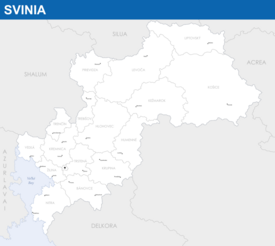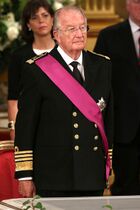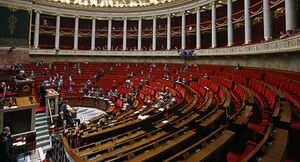User:Lihnidos/Sandbox2
Empire of Svinia Ríše Švíka (Svin) | |
|---|---|
|
Flag | |
| Motto: Sledovať svoje vlastné hviezdu ("Follow your own star") | |
| Anthem: Nad Tatrou sa blýska ("Lightning over the Tatras") | |
 | |
| Capital | Hrabské |
| Largest | Sveta |
| Official languages | Svin |
| Recognised regional languages | Shalumite Æsthurlav Norse Acrean Standard |
| Ethnic groups | 74.9% Svinian 8.1% Æsthurlav 6.2% Shalumite 4.1% Acrean 6.7% Other |
| Demonym(s) | Svinian |
| Government | Federal parliamentary constitutional monarchy |
• Emperor | Drahoslav IV |
• Premier | Marián Kudrna |
| Legislature | Parliament |
| Senate | |
| National Assembly | |
| Formation | |
• Founding of Svinia | 600 BC |
• Under the Acrean Empire | 400 BC - 460 AD |
• Svinian Empire | 600 AD |
• First constitution | 1849 |
• Justínan reforms | 1940 |
| Area | |
• | 1,455,055 km2 (561,800 sq mi) |
| Population | |
• 2018 estimate | 193,541,235 |
• 2014 census | 191,693,965 |
• Density | 131.75/km2 (341.2/sq mi) |
| GDP (PPP) | 2019 estimate |
• Total | $7.814 trillion |
• Per capita | $40,762.89 |
| Gini | 41.7 medium |
| HDI | .856 very high |
| Currency | Koruna ( |
| Date format | dd.mm.yyyy |
| Driving side | right |
| Calling code | +57 |
| ISO 3166 code | SV |
| Internet TLD | .svn |
Etymology
History
Prehistory
Slavic tribes and Acrean Empire
Slavic states
Svinian Empire
Constitution and reforms
Contemporary period
Geography
Climate
Biodiversity
Politics
Government
 |

|
| Drahoslav IV Emperor since 1985 |
Marián Kudrna Premier since 2012 |
Svinia is a federal, parliamentary, constitutional monarchy. The Svinian political system is laid out in the 1849 constitution approved by the monarch at the time, Radovan IV, that later underwent significant reforms in 1940. Further amendments to the constitution require a two-thirds majority in both the National Assembly and Senate, as well as approval of two-thirds of each state legislatures and the monarch. The 1940 reforms strengthened the principle of separation of powers by increasing the powers of the legislature and limiting executive authority held by the monarch.
The executive branch is led by the monarch, currently Emperor Drahoslav IV. The monarch is the head of state and exercises their executive power through the Office of the Emperor (or Empress), also known as the Imperial Office. The monarch has representative responsibilities and powers and takes a significant role in establishing foreign policy. Each monarch begins their reign following the death of their predecessor. The monarch is considered to be the highest official in the Svinian government.
The second-highest official in the Svinian government is the Premier. The current Premier is Marián Kudrna, who has led the government in the National Assembly since 2012. The Premier is the head of government and the legislative branch. Alongside their legislative duties, the Premier exercises their executive power through their Cabinet. The Premier and Cabinet exercise executive power in conjunction with the monarch.
Legislative power is exercised by the National Assembly and Senate. Together, the National Assembly and Senate form the bicameral legislature of Svinia and each hold different roles. The National Assembly is elected through direct elections by mixed-member proportional representation. Elections for the National Assembly are held a minimum of every four years. The Senate is a collection of representatives from the seventeen states and are appointed by state cabinets. Representation for each state is determined by the state's population.
The current government is a coalition government led by the Conservative Party with the National Party as a junior partner. Together, the Conservative Party and National Party hold a slim majority in the National Assembly. Since the creation of the National Assembly under the constitution in 1849 the Conservative Party has been one of the two major political parties that have dominated elected politics. The other major political party in Svinia is the Liberal Democratic Party. Since 1936, every premier has been a member of either the conservatives or liberal democrats.
Law
Svinian law is based on civil law. The civil law system is based on codified principles that serve as a primary source for legal decisions. In Svinia, these principles are codified in the Svinian Civil Code and the Svinian Penal Code, which were adopted in 1849 under the first constitution of the empire. The Svinian Civil Code was largely based off of the Valentínian Royal Laws established by Valentín II.
Law in Svinia is primarily divided into two areas: public law and private law. Public law includes several aspects of the relationship between the government and individuals, comprising constitutional law, administrative law, tax law, and others. Private law primarily deals with the relationship between individuals. The Svinian judiciary is divided into two different courts to deal with these issues. The general courts deal with criminal and civil trials, while the courts of public law deal with administrative and constitutional law.
The government of Svinia recognizes no religion as a state religion and promotes freedom of religion and freedom of speech. Despite this, the clear religion majority in Svinia has resulted in numerous laws that are aimed at upholding public decency and that are based off of religious law. These laws have been widely used to limit the freedoms of LGBT individuals and other minority groups and place limits on speech. These laws have been widely criticized by both domestic and international groups. The most notable international criticism has come from Gylian government agencies like the Bureau of Religious Affairs and Directorate for Action Against Discrimination.
Administrative divisions
Svinia is divided into seventeen constituent states, one of which is a city-state consisting of just one city: the national capital region of Hrabské. These states are further divided into counties and municipalities. States are also divided into constituencies, which are used to elect half of the National Assembly. Constituency boundaries typically do not follow the boundaries set by counties. The State of Hrabské is the only state to not have any further administrative divisions within.
The states, counties, and municipalities are all governed by localized assemblies and executives. Each state possesses its own laws and legislative bodies and are largely self-governing. All states possess a unicameral legislature known as the state assembly that elect a state chancellor who in turn appoints a state cabinet. The state chancellor, state cabinet, and state assembly are the main governing authorities within each state. Each county is governed by a county commission composed of three county commissioners. County commissioners will work with other county officials to govern the county and manage local taxes and spending. Municipalities are typically governed by a mayor and small municipal council, however there is no set format for municipal governance.
Due to the differing size and population, the number of counties and municipalities differs by state. Each state government is given the authority to draw internal administrative division boundaries, with the only exception being National Assembly constituency boundaries.
|


